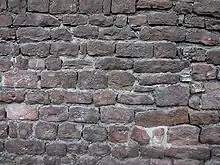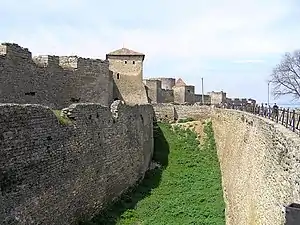Stone wall
Stone walls are a kind of masonry construction that has been used for thousands of years. The first stone walls were constructed by farmers and primitive people by piling loose field stones into a dry stone wall. Later, mortar and plaster were used, especially in the construction of city walls, castles, and other fortifications before and during the Middle Ages. These stone walls are spread throughout the world in different forms. One of the best example is the Cyclopean Wall in Rajgir, India.[1]





Materials
Stone walls are usually made of local materials varying from limestone and flint to granite and sandstone. However, the quality of building stone varies greatly, both in its endurance to weathering, resistance to water penetration and in its ability to be worked into regular shapes before construction. Worked stone is usually known as ashlar, and is often used for corners in stone buildings. Granite is very resistant to weathering, while some limestones are very weak. Other limestones, such as Portland stone, are more weather-resistant.
Dimensions
Large structures are usually made of very thick walls, so that castles and cathedrals possess walls which may be up to 12 feet thick. They normally consist of a layered stone exterior and rubble infill.
See also
- Dry-stone wall
- Defensive wall – Fortification used to protect an area from potential aggressors
- Fieldstone
- NIST stone test wall
- Stonemasonry – creation of buildings, structures, and sculpture using stone
References
- "The Cyclopean Wall Rajgir". Travel News India. 2017-03-07. Retrieved 2017-03-09.
| Wikimedia Commons has media related to Stone walls. |